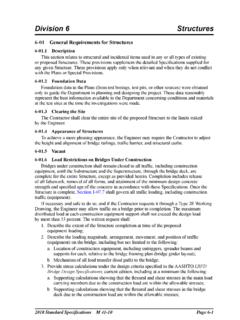Transcription of Calling C and Fortran Programs from MATLAB
1 3 Calling C and Fortran Programs from MATLABA lthough MATLAB is a complete, self-contained environment for programming and manipulating data , it is often useful to interact with data and Programs external to the MATLAB environment. MATLAB provides an interface to external Programs written in the C and Fortran languages. Introducing MEX-Files (p. 3-2)Using MEX-files, mx routines, and mex routinesMATLAB data (p. 3-4) data types you can use in MEX-filesBuilding MEX-Files (p. 3-9)Compiling and linking your MEx-fileCustom Building MEX-Files (p. 3-18) Platform-specific instructions on custom buildingTroubleshooting (p. 3-28)Troubleshooting some of the more common problems you may encounterAdditional Information (p. 3-38)Files you should know about, example Programs , where to get help3 Calling C and Fortran Programs from MATLAB3-2 Introducing MEX-FilesYou can call your own C or Fortran subroutines from MATLAB as if they were built-in functions.
2 MATLAB callable C and Fortran Programs are referred to as MEX-files. MEX-files are dynamically linked subroutines that the MATLAB interpreter can automatically load and have several applications: Large pre-existing C and Fortran Programs can be called from MATLAB without having to be rewritten as M-files. Bottleneck computations (usually for-loops) that do not run fast enough in MATLAB can be recoded in C or Fortran for are not appropriate for all applications. MATLAB is a high-productivity system whose specialty is eliminating time-consuming, low-level programming in compiled languages like Fortran or C. In general, most programming should be done in MATLAB . Don t use the MEX facility unless your application requires MEX-FilesMEX-files are subroutines produced from C or Fortran source code. They behave just like M-files and built-in functions. While M-files have a platform-independent extension.
3 M, MATLAB identifies MEX-files by platform-specific extensions. This table lists the platform-specific extensions for 3-1: MEX-File Extensions PlatformMEX-File ExtensionHP-UXmexhpuxLinuxmexglxMacintos hmexmacSolarismexsolWindowsdllIntroducin g MEX-Files3-3 You can call MEX-files exactly as you would call any M-function. For example, a MEX-file called on your disk in the MATLAB datafun toolbox directory performs a 2-D convolution of matrices. only contains the help text documentation. If you invoke the function conv2 from inside MATLAB , the interpreter looks through the list of directories on the MATLAB search path. It scans each directory looking for the first occurrence of a file named conv2 with the corresponding filename extension from the table or .m. When it finds one, it loads the file and executes it. MEX-files take precedence over M-files when like-named files exist in the same directory.
4 However, help text documentation is still read from the .m Distinction Between mx and mex PrefixesRoutines in the API that are prefixed with mx allow you to create, access, manipulate, and destroy mxArrays. Routines prefixed with mex perform operations back in the MATLAB RoutinesThe array access and creation library provides a set of array access and creation routines for manipulating MATLAB arrays. These subroutines, which are fully documented in the online API reference pages, always start with the prefix mx. For example, mxGetPi retrieves the pointer to the imaginary data inside the most of the routines in the array access and creation library let you manipulate the MATLAB array, there are two exceptions the IEEE routines and memory management routines. For example, mxGetNaN returns a double, not an RoutinesRoutines that begin with the mex prefix perform operations back in the MATLAB environment.
5 For example, the mexEvalString routine evaluates a string in the MATLAB mex routines are only available in Calling C and Fortran Programs from MATLAB3-4 MATLAB DataBefore you can program MEX-files, you must understand how MATLAB represents the many data types it supports. This section discusses the following topics: The MATLAB Array data Storage data Types in MATLAB Using data Types The MATLAB ArrayThe MATLAB language works with only a single object type: the MATLAB array. All MATLAB variables, including scalars, vectors, matrices, strings, cell arrays, structures, and objects are stored as MATLAB arrays. In C, the MATLAB array is declared to be of type mxArray. The mxArray structure contains, among other things: Its type Its dimensions The data associated with this array If numeric, whether the variable is real or complex If sparse, its indices and nonzero maximum elements If a structure or object, the number of fields and field namesData StorageAll MATLAB data is stored columnwise, which is how Fortran stores matrices.
6 MATLAB uses this convention because it was originally written in Fortran . For example, given the matrixa=['house'; 'floor'; 'porch']a = house floor porchMATLAB Data3-5its dimensions aresize(a)ans = 3 5and its data is stored asData Types in MATLABC omplex Double-Precision MatricesThe most common data type in MATLAB is the complex double-precision, nonsparse matrix. These matrices are of type double and have dimensions m-by-n, where m is the number of rows and n is the number of columns. The data is stored as two vectors of double-precision numbers one contains the real data and one contains the imaginary data . The pointers to this data are referred to as pr (pointer to real data ) and pi (pointer to imaginary data ), respectively. A real-only, double-precision matrix is one whose pi is MatricesMATLAB also supports other types of numeric matrices. These are single-precision floating-point and 8-, 16-, and 32-bit integers, both signed and unsigned.
7 The data is stored in two vectors in the same manner as double-precision MatricesThe logical data type represents a logical true or false state using the numbers 1 and 0, respectively. Certain MATLAB functions and operators return logical 1 or logical 0 to indicate whether a certain condition was found to be true or not. For example, the statement (5 * 10) > 40 returns a logical 1 Calling C and Fortran Programs from MATLAB3-6 MATLAB StringsMATLAB strings are of type char and are stored the same way as unsigned 16-bit integers except there is no imaginary data component. Unlike C, MATLAB strings are not null ArraysCell arrays are a collection of MATLAB arrays where each mxArray is referred to as a cell. This allows MATLAB arrays of different types to be stored together. Cell arrays are stored in a similar manner to numeric matrices, except the data portion contains a single vector of pointers to mxArrays.
8 Members of this vector are called cells. Each cell can be of any supported data type, even another cell 1-by-1 structure is stored in the same manner as a 1-by-n cell array where n is the number of fields in the structure. Members of the data vector are called fields. Each field is associated with a name stored in the are stored and accessed the same way as structures. In MATLAB , objects are named structures with registered methods. Outside MATLAB , an object is a structure that contains storage for an additional classname that identifies the name of the ArraysMATLAB arrays of any type can be multidimensional. A vector of integers is stored where each element is the size of the corresponding dimension. The storage of the data is the same as ArraysMATLAB arrays of any type can be empty. An empty mxArray is one with at least one dimension equal to zero. For example, a double-precision mxArray of type double, where m and n equal 0 and pr is NULL, is an empty Data3-7 Sparse MatricesSparse matrices have a different storage convention than full matrices in MATLAB .
9 The parameters pr and pi are still arrays of double-precision numbers, but there are three additional parameters, nzmax, ir, and jc: nzmax is an integer that contains the length of ir, pr, and, if it exists, pi. It is the maximum possible number of nonzero elements in the sparse matrix. ir points to an integer array of length nzmax containing the row indices of the corresponding elements in pr and pi. jc points to an integer array of length N+1 that contains column index information. For j, in the range 0 j N-1, jc[j] is the index in ir and pr (and pi if it exists) of the first nonzero entry in the jth column and jc[j+1] - 1 index of the last nonzero entry. As a result, jc[N] is also equal to nnz, the number of nonzero entries in the matrix. If nnz is less than nzmax, then more nonzero entries can be inserted in the array without allocating additional data TypesYou can write MEX-files, MAT-file applications, and engine applications in C that accept any data type supported by MATLAB .
10 In Fortran , only the creation of double-precision n-by-m arrays and strings are supported. You can treat C and Fortran MEX-files, once compiled, exactly like explore ExampleThere is an example MEX-file included with MATLAB , called explore, that identifies the data type of an input variable. The source file for this example is in the < MATLAB >/extern/examples/mex directory, where < MATLAB > represents the top-level directory where MATLAB is installed on your In platform independent discussions that refer to directory paths, this book uses the UNIX convention. For example, a general reference to the mex directory is < MATLAB >/extern/ Calling C and Fortran Programs from MATLAB3-8 For example, typingcd([matlabroot '/extern/examples/mex']);x = 2;explore(x);produces this result---------------------------------- --------------Name: prhs[0]Dimensions: 1x1 Class Name: double---------------------------------- --------------(1,1) = 2explore accepts any data type.









